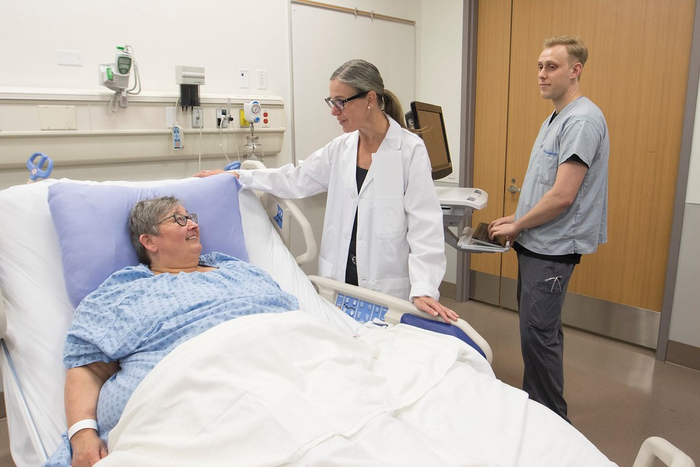Globally, the burgeoning burden of obesity is aggravated by the limitations of available treatment options. Bariatric surgery, aimed at weight loss, falls short of addressing certain patient groups, such as those who are overweight but only mildly obese. This necessitates the need for alternative procedures to cater to the needs of patients with obesity. In recent years, endoscopic sleeve gastroplasty (ESG), a minimally invasive weight loss procedure, has emerged as an alternative to bariatric surgery. Evidence from studies detailing ESG outcomes could help us understand the implications for its future usage and guide further developments.

Credit: “#Bariatric care A0208” by Obésité Canada
Globally, the burgeoning burden of obesity is aggravated by the limitations of available treatment options. Bariatric surgery, aimed at weight loss, falls short of addressing certain patient groups, such as those who are overweight but only mildly obese. This necessitates the need for alternative procedures to cater to the needs of patients with obesity. In recent years, endoscopic sleeve gastroplasty (ESG), a minimally invasive weight loss procedure, has emerged as an alternative to bariatric surgery. Evidence from studies detailing ESG outcomes could help us understand the implications for its future usage and guide further developments.
Building on the available data, researchers from Brazil have recently documented the origin and developments of ESG, along with insights on its safety, efficacy, and clinical guidelines. Their findings were published as a narrative review online on March 5, 2022, and in Volume 135, Issue 7 of the Chinese Medical Journal on April 5, 2022. Highlighting the significance of this review, Professor Vitor Ottoboni Brunaldi from the University of Sao Paulo (the corresponding author of this study) tells us, “This article sums up both traditional and current data on endoscopic sleeve gastroplasty as a treatment for obesity.”
ESG was first introduced in 2013. It is also known as the “Apollo method” after the Apollo OverStitch, a full thickness endoscopic suturing device used in this procedure. ESG involves altering the shape of the stomach from a bean-like fashion to a tubular one. Over time, the technique has evolved to employ several running stitches along the stomach’s body instead of numerous interrupted stitches. The suturing pattern, however, did not seem to affect weight loss outcomes.
With time, though, owing to the complications and efforts involved in the process, suturing the gastric fundus region (i.e., the upper part of the stomach) has now been abandoned. This proved to be a blessing in disguise, as Professor Brunaldi points out, “The fundal pouch plays an important role in the physiology of weight loss as evidence suggests that the fundus retains food, and therefore delays gastric emptying.”
This concept of delayed gastric emptying might be what ESG’s success is based on. It could result in greater satisfaction and a decrease in caloric intake, favoring weight loss. Professor Brunaldi does, however, have a clarification to make: “The physiology behind weight loss following the procedure is not clear yet; however, the available shreds of Evidence suggest that delayed gastric emptying is pivotal.”
Nonetheless, the total weight loss at 18 to 24 months after ESG was reported to be between 18% to 20%. Various studies report positive outcomes in favor of the procedure. For example, the review discusses a recent study which demonstrated that ESG induces a more pronounced weight loss than a high-intensity diet plus lifestyle modifications. “This procedure helps in resolving obesity-related conditions like type 2 diabetes, hypertension, dyslipidemia, and gastroesophageal reflux disease as well,” Professor Brunaldi explains. The procedure is also durable in the long term, and weight loss it facilitates could be improved with the use of adjunct pharmacotherapy.
Moreover, most adverse events reported with ESG were of a mild-to-moderate severity and could be managed with non-operative treatment. Pain and nausea necessitating hospital admission were the most frequently reported adverse events. Other issues that arise post-ESG, like gallbladder perforation, peritoneal adhesions, and gastric imbrication, can also be managed safely.
The available evidence indicates that the use of ESG as a therapeutic option has increased exponentially. So, how do these findings translate into better outcomes for the management of obesity? Professor Brunaldi says, “The evidence from existing data already supports the use of ESG on a routine basis. ESG could also be a bridging procedure for bariatric surgery of extremely high-risk patients.”
While the results of randomized clinical trials are awaited, successful outcomes have already encouraged the usage of ESG to manage weight regain after other weight loss procedures.
***
Reference:
DOI: https://doi.org/10.1097/CM9.000000000000209
Journal
Chinese Medical Journal
DOI
10.1097/CM9.0000000000002098
Method of Research
Literature review
Subject of Research
Not applicable
Article Title
Endoscopic sleeve gastroplasty: a narrative review on historical evolution, physiology, outcomes, and future standpoints
Article Publication Date
5-Apr-2022
COI Statement
Dr. Brunaldi reports receiving personal fees for lectures from Erbe Elektromedizin GmbH; Dr. Galvao Neto also received personal fees for lectures from Erbe Elektromedizin GmbH; is consultant for GI Dynamics, Apollo EndoSurgery, USGI, Colubris Mx, Scitech, and MITech, outside the submitted work; is Scientific Advisor for Apollo EndoSurgery and Keyron; is speaker for Olympus LA, Erbe, and Meditronics LA, outside the submitted work. All authors read and approved the final version of this manuscript.




